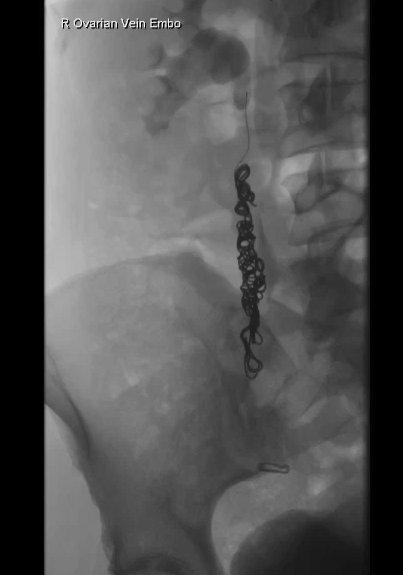
Pelvic Congestion Syndrome
Pelvic/Ovarian Vein Congestion
Pelvic or ovarian vein congestion, also known as pelvic congestion syndrome (PCS), refers to the presence of varicose veins in the pelvic region, particularly affecting the ovarian veins. These veins become dilated and tortuous, leading to pooling of blood and increased venous pressure.
Pelvic vein congestion is often caused by:
○ Valve dysfunction in the ovarian veins leading to reflux and venous insufficiency.
○ Compression of pelvic veins by surrounding structures (e.g., May-Thurner syndrome or nutcracker syndrome).
○ Hormonal influences, particularly elevated oestrogen levels causing vein dilation.
Symptoms
Symptoms of pelvic/ovarian vein congestion include:
Chronic dull pelvic pain, often described as a heaviness or aching.
Pain that gets worse after standing for long periods.
Pain during or after intercourse, or before menstruation.
Visible varicose veins in the vulva, buttocks, or inner thighs.
Lower back pain.
Urinary urgency or frequency.
Treatment options
The treatment options for pelvic or ovarian vein congestion aim to relieve symptoms by reducing the abnormal blood flow and pressure in the affected veins.
Conservative approaches include pain management, compression garments, lifestyle modification (weight management, avoiding prolonged standing).
For more significant cases, minimally invasive procedures are often recommended:
○ Ovarian vein embolisation (OVE) is the most common, where a catheter is inserted into the vein and tiny coils or plugs are placed to block the faulty vein, redirecting blood flow and relieving pressure.
○ Pelvic vein embolisation may also be performed to close off other problematic veins.
These procedures are usually done under local anaesthesia or conscious sedation, offering quick recovery and effective symptom relief.
In rare cases where embolisation is not effective, surgical options such as vein ligation or hysterectomy may be considered.
Ovarian Vein Embolisation Procedure
Before the procedure:
You will have a consultation with an Interventional Radiologist where your imaging, medications and blood tests will be reviewed.
Procedure:
A small catheter is inserted through a vessel in the wrist or groin and guided to the ovarian veins.
Abnormal veins are embolised (blocked) while preserving normal blood flow.
Duration:
1–2 hours
Recovery:
Same day procedure, no admission required.
Normal activities can resume within days.
After the procedure:
Follow-up with your Interventional Radiologist in 3–6 months with repeat ultrasound scan. This will be arranged for you.



